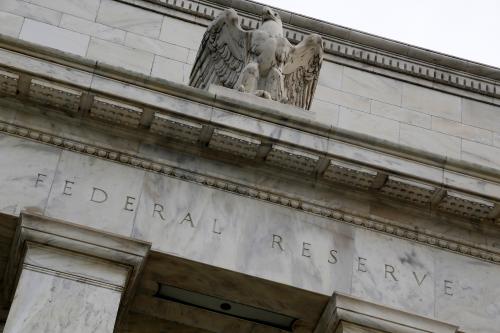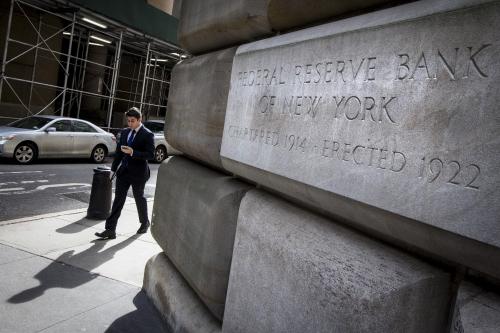It is easy to dismiss the Democratic Party’s latest attack on the lack of diversity within the Federal Reserve, inserting a specific plank in the party’s platform on this point, as standard campaign season Fed bashing. However, in this case, there is strong data to support the claim that the regional Federal Reserve Banks have structural problems in generating diverse leadership and that the lack of diverse leaders has negative repercussions.
Some background. The Fed is the nation’s central bank, setting monetary policy with a dual mandate to maximize employment, and stabilize prices; in addition, it supervises and regulates banks, systemically important financial institutions, and performs substantial economic research. It is a government agency, centered on its the Federal Reserve Board, headed by a presidentially appointed Board of Governors and 12 regional Federal Reserve Banks, which are government-created but privately run institutions that are ultimately responsible to the Board.
Thanks to the financial crisis and deep recession of 2007-2008, the Federal Reserve, ostensibly seen as one of the major actors in the economy, has been a convenient political piñata, swung at blindly for easy political gain. This is by design: central banks operate at their best when taking economically wise but politically unpopular actions, which is why their status as an independent regulator is so important. It is a testament to the designers of the Federal Reserve System, America’s third version of our central bank, that it has endured for over 100 years. The nation’s first two central banks lasted for less than 40 years combined. [1] Yet there is a real problem with the Federal Reserve System as it relates to its governance and the selection process of the regional Federal Reserve Bank Presidents.
Throughout the history of the Federal Reserve System, there have been 134 different presidents of Federal Reserve Regional Banks. Of those 134 presidents, zero have been African American. There have also been zero Latino presidents. Until 2009, there had never been a non-white Federal Reserve Regional Bank President. Since then, the only two non-white presidents have been from the Minneapolis Federal Reserve Bank, current President Neel Kashkari and his immediate predecessor, Narayana Kocherlakota. The other 11 Federal Reserve Regional Banks still have never had a single non-white president.[2]
This lack of diversity extends beyond race. Eight of the 12 Federal Reserve Regional Banks have never had a woman president. There have been only six women to serve in this role in history, and half of them have been President of the Cleveland Federal Reserve Bank, including Karen Horn who, in 1982, became the first woman to serve in such a role.[3]
Federal Regional Bank Presidents are important: they vote to determine the nation’s monetary policy, have significant authority over bank regulation, and lead on-the-ground teams of regulators and supervisors for our nation’s banks, bank holding companies, and systemically important financial institutions. Their banks have a combined $3 billion operating budget, and together oversee the largest economics research program in America.
Numerous empirical studies have proven the obvious: the background of senior leaders impacts their decision-making process and influences their interests. [4] As the Government Accountability Office (GAO) found in a recent report investigating the lack of diversity among Federal Reserve Regional Bank Boards, “Having a demographically and economically diverse board strengthens an organization by bringing a wider variety of perspectives and approaches to the organization…. Such diversification can help ensure that the Federal Reserve System receives a broader spectrum of information useful for the formation and execution of monetary policy and the oversight of Reserve Bank operations.”[5] Diversity of leadership strengthens the institution’s legitimacy, a key goal of the Federal Reserve System, given its inherent need to take politically unpopular actions. [6] Ensuring diversity of background was a main goal of creating the regional Federal Reserve Bank system in the first place, so that monetary policy and bank regulation would not be set only by politically appointed officials in Washington, but rather that voices across the country would be heard.
While geographic diversity is important, so too are gender, race, educational background, and occupation. The Fed’s current homogeneity is not just a matter of race or gender. Prior research demonstrated that the vast majority of Federal Reserve Regional Bank Presidents were former Fed employees themselves or had been members of the Regional Bank’s Board before being appointed[7], and that the senior economists at the Federal Reserve Banks and Board have been clustered in a small number of university economics departments.[8] A lack of diversity of background, experience, and vantage points can lead to group-think and collective misjudgments.
Solutions to this problem are difficult. The banking industry felt that its power was being reduced at the Fed, from a combination of a change in Dodd-Frank that prohibited bankers who serve on the Federal Reserve Regional Bank Boards from being directly involved in the selection process for new Regional Bank Presidents, and President Obama’s decision to not appoint any existing bankers to serve on the Fed’s Board of Governors. The banking industry successfully lobbied Congress to impose a quota system and require at least one Fed Board Governor to be from a small bank (aka, a community banker). President Obama nominated Al Landon to serve in that role, but the Senate has yet to grant him a hearing, over 500 days later.[9]
The Fed’s Board of Governors are presidentially appointed and have a track record of greater diversity than the Regional Banks, although there have only been three non-white Federal Reserve governors and only nine women, out of 94 different Fed governors. Andrew Brimmer, the first African American Fed Governor, was appointed in 1966, more than 40 years before a Regional Bank appointed any person of color as president. More recently, Roger Ferguson served as vice-chairman of the Fed, becoming the highest ranking African American in Fed history. The Board of Governors has had greater success in gender diversity, culminating with the selection of current Chair, Janet Yellen. Beyond that, though, there have been times during the last ten years in which a majority of Federal Reserve Governors were women. The Board of Governors record demonstrates that there is no shortage of highly qualified women and minorities to serve in senior leadership positions at the Fed.
The Federal Reserve’s Board of Governors has some legal authority and power over the nomination of a Regional Bank President that it could use more effectively. In theory, the Fed’s Board of Governors could openly oppose or veto the selection of a Regional Bank President, though they have not used this power in recent memory. Troublingly, the Board of Governors approved an appointment where there was a substantial breakdown in transparency and fairness. In 2015, the Philadelphia Federal Reserve Bank selected Patrick Harker to serve as president. Harker was a member of the Philadelphia Fed’s Board and had served on the search committee, interviewing other applicants before deciding to seek the position himself. He was appointed in less than 10 days, with the consent of the Board of Governors.[10]
Greater transparency in the selection process for Regional Bank Presidents has been proposed by Andrew Levin, a Dartmouth College economics professor, who called for “genuine public participation through hearings and other forms of input and feedback” by the public during a Regional Bank’s presidential selection process.[11] It is not clear whether having public job interviews would produce better results. However, having clear and publicly stated criteria, greater public outreach, and a more transparent final decision-making process are reasonable steps that Reserve Banks could take to improve this process. The call for more transparency is consistent with a GAO recommendation “that Reserve Banks make public key governance documents, such as bylaws, ethics policies, and committee assignments, by posting them to their websites.”[12]
Finally, a sports comparison. The National Football League (NFL), in an attempt to increase minority head coaches, instituted the so-called “Rooney Rule” whereby every team had to at least consider and interview a minority candidate. As NFL coaching job interviews are somewhat public in that the media usually reports on those being interviewed, one of the goals was to increase the public profile of potential candidates. However, there is not great evidence that the Rooney Rule has been successful — teams have not always followed the spirit or letter of the rule. There has been no indication that Federal Reserve Banks have failed to interview minority candidates. The only data we have is that they have failed to actually hire them.
The Democratic Party’s decision to highlight this issue will increase pressure on Federal Reserve system to strongly consider diversity when making future appointments, given that the status quo has failed to result in women and minority candidates being selected at most Federal Reserve Banks. However, it is troubling when political parties go down the road of Fed bashing. Furthermore, if the model for success was found by industry in creating a quota for bankers, it is not clear that a better system for selection has been found. What is unfortunate is that we are at this place to begin with. More than 40 years ago, presidents of the United States found distinguished and diverse candidates to serve on the Federal Reserve Board of Governors. Why can’t the Regional Banks do the same?
[1] The first national bank was given a 20 year charter in 1791 which the senate failed to renew in 1811. The second national bank was awarded a 20 year charter in 1816. The bank formally died in 1836 when its charter expired, but had really been destroyed by Jackson 3 years earlier, when he removed federal deposits and diverted revenue from the bank.
[2] http://www.federalreservehistory.org/People
[3] http://www.federalreservehistory.org/People/DetailView/204
[4] Bratton, Kathleen A., and Kerry L. Haynie. 1999. “Agenda Setting and Legislative Success in State Legislatures: The Effects of Gender and Race.” Journal of Politics 61:658-79.
[5] http://www.gao.gov/assets/590/585807.pdf
[6] Scherer, Nancy, and Brett Curry. 2010. “Does Descriptive Race Representation Enhance Institutional Legitimacy? The Case of the U.S. Courts.” Journal of Politics 72: 90-104.
[7] http://bipartisanpolicy.org/blog/reform-the-fed-get-rid-of-groupthink/
[8] http://www.cato.org/blog/yes-federal-reserve-has-diversity-problem
[9] Bipartisan Policy Center Nominations Tracker
[10] http://www.bloomberg.com/news/articles/2015-06-03/not-far-to-look-fed-s-newest-president-searched-found-himself
[11] https://populardemocracy.org/sites/default/files/Federal%20Reserve%20Reform%20Proposal%2008apr2016.pdf
[12] http://www.gao.gov/assets/590/585807.pdf
The author wishes to acknowledge the assistance of intern Alex Magnuson who conducted research for this piece.
Editor’s note: Klein has served as an unpaid member of the Clinton campaign’s Infrastructure Finance Working Group; he has not served as an advisor on any banking or finance issues.
The Brookings Institution is committed to quality, independence, and impact.
We are supported by a diverse array of funders. In line with our values and policies, each Brookings publication represents the sole views of its author(s).










Commentary
Op-edThe Fed’s striking lack of diversity and why it matters
August 1, 2016